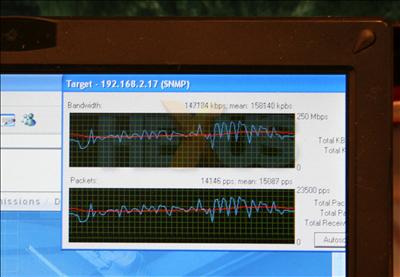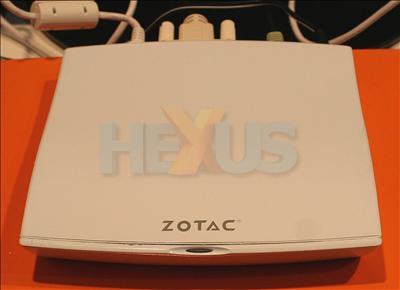ZOTAC is one of only six NVIDIA partners to have a booth at this year's show, but it did have at least one very interesting product behind semi-closed doors.
What you're looking at is a regular PC whose graphics card output is plugged into a special card at the bottom. The purpose of this card is to take the video that would normally be shown on your regular screen, compress it, and then send it over, via Ethernet or WiFi, to the device shown below.
The card, connected via a PCIe interface, uses established PCoIP (PC-over-IP) technology - already used by certain Samsung monitors and high-end Dell hardware - to compress and push the signal from host machine to recipient device, and ZOTAC's pre-production version is limited to 250Mbps, making it possible to transfer via certain draft 802.11n WiFi hardware.
Here's the box of tricks on the other end, linked, in this case, via Cat 5 cable.

The point here, we suppose, is to export any video, irrespective of how it's produced, to a much smaller, quieter box that has connectivity options to hook up to a large screen in, say, the lounge. The system is agnostic of the video, so you could have a Core i7 machine with three-way SLI in the bedroom, and the video could be compressed and exported to another display in the home without moving the actual hardware. In effect, it replicates the PC without having it present.
The receiving unit sports a wake-on PC feature, such that you can control the host PC's state, and the compression is good enough that at 250Mbps the resulting video - be it gaming or high-definition media - shows no apparent quality degradation. We observed a very slight lag between keyboard inputs and the screen updating, making it unsuitable for frenetic gaming, and using 802.11n may well incur dropped frames.
Further, this kind of system would be a perfect partner for HomePlug, transferring the video via the mains, but such is the speed restriction on the majority of shipping products, that it would require throttling the bandwidth back to levels where obvious quality degradations would be observed. Lastly, the demonstration system wasn't able to process HDCP-protected content either.
Come the days of widespread 100Mbit/s broadband and this kind of technology will really come into its own, letting you play the latest games on a small laptop should you be on your travels. A concept right now but due to be launched at some point later on this year, we reckon it could work if priced at <£150. What do you think?









